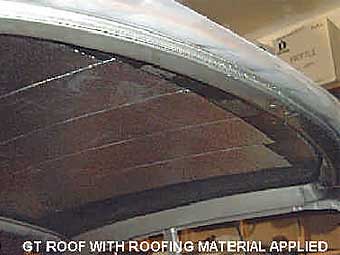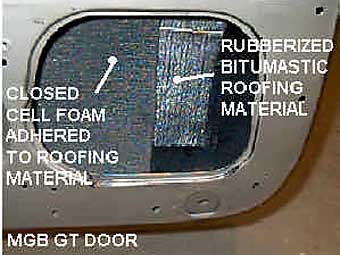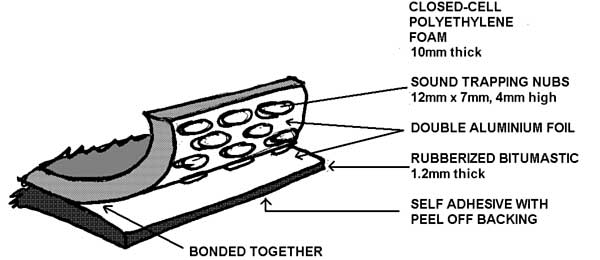�
�
�
�
�
�
�
 �
�
 �
�
�
� by: Barrie Robinson�
� I get carried away sometimes and spend far too much time "researching". I � constantly battle with getting back to the basics of building my MGB GT V8 � instead of exploring all the possibilities out there. Incidentally, I have � found the aircraft industry a gold mine of exotic products. I have now some � fantastic anti-seize, anti-rust and anti-anti stuff to say nothing of � incredible fasteners. My prop shaft bolts are those used on helicopter � blades, rated at ten-gazillion sheer force. Not only that, but a paint-on � liquid that they use for aircraft exhausts which acts just like a ceramic � coating. �
�
�
�
 �
�
 �
�
Sort of Sound Advice
� (originally published in British V8 Newsletter, Volume X Issue 3, September 2002)�� by: Barrie Robinson�
� I get carried away sometimes and spend far too much time "researching". I � constantly battle with getting back to the basics of building my MGB GT V8 � instead of exploring all the possibilities out there. Incidentally, I have � found the aircraft industry a gold mine of exotic products. I have now some � fantastic anti-seize, anti-rust and anti-anti stuff to say nothing of � incredible fasteners. My prop shaft bolts are those used on helicopter � blades, rated at ten-gazillion sheer force. Not only that, but a paint-on � liquid that they use for aircraft exhausts which acts just like a ceramic � coating. �
�
�
At the beginning of my madness several things about the building of a MGB �
GT V8 gave me cause for thought. One was cooling and after much thought �
this was solved with a D&D Fabrications heavy duty radiator, a specially �
shortened water pump, a Perma-Cool 2,950cfm puller electric radiator fan, �
and a beautiful stainless steel through-the-fender Australian exhausts �
(which I now sell).�
� The other area that needed some ponder was sound (as in noise). Now I am � not an armchair driver who wants to only hear the clock ticking and I do � like to hear the engine growl. Neither am I one of those people with the � intelligence quotient of a piece of burnt toast that spend thousands on � "hi-fi" systems for their cars. That's like wearing a Saville row-suit in � a hot tub. So I did some looking around. Naturally the first stuff that � took my eye was Dynamat and after that some other similar products.�
� The first thing that puzzled me about these products from Dynamat and people � like B-Quiet was that the aluminum foil was on the wrong side. So I phoned � a supplier and had a conversation with a "technical person". My argument � was that if the product was to reflect the heat of the sun out of the car � then this should be next to the metal of car's body. So from the outside it � should be car body, adhesive, aluminum foil, rubberized bitumastic/polymer � stuff or whatever (technically called the "goop"). The "technical person" � said no, the heat went through the car body, through the goop, reflected � off the foil, back through the goop and out. This I found somewhat nonsensical � and reasoned that the product was obviously not designed for sound deadening � in automobiles.�
��
�
� Well, it turns out that this is, in fact, the case! The product is nothing � more that roofing material as used by construction people. It is readily � available in a variety of sizes and types from your local roofing contractor � at 1/10 the price. As to the goop, your schoolboy physics will remind you � that there is little difference between them all you want is mass! Just get � one that stands up to the heat, and they all do! Also do not get excited � about the aluminum foil. Just because it keeps roofs cool by reflecting � sunlight does not mean it will be as effective in the dark. If you have a � resonating panel it is easily stopped by putting your hand on it. It kills � the vibration. So just imagine your hand being replaced by a patch of � something, something like rubberized bitumen! By stopping the vibration of � the panel you stop the drumming, thrumming, and rumbling.�
�
�
�
� The other area that needed some ponder was sound (as in noise). Now I am � not an armchair driver who wants to only hear the clock ticking and I do � like to hear the engine growl. Neither am I one of those people with the � intelligence quotient of a piece of burnt toast that spend thousands on � "hi-fi" systems for their cars. That's like wearing a Saville row-suit in � a hot tub. So I did some looking around. Naturally the first stuff that � took my eye was Dynamat and after that some other similar products.�
� The first thing that puzzled me about these products from Dynamat and people � like B-Quiet was that the aluminum foil was on the wrong side. So I phoned � a supplier and had a conversation with a "technical person". My argument � was that if the product was to reflect the heat of the sun out of the car � then this should be next to the metal of car's body. So from the outside it � should be car body, adhesive, aluminum foil, rubberized bitumastic/polymer � stuff or whatever (technically called the "goop"). The "technical person" � said no, the heat went through the car body, through the goop, reflected � off the foil, back through the goop and out. This I found somewhat nonsensical � and reasoned that the product was obviously not designed for sound deadening � in automobiles.�
�
| �
Enjoying this article? Our magazine is funded through the generous support of readers like you! � To contribute to our operating budget, please click here and follow the instructions. � (Suggested contribution is twenty bucks per year. Feel free to give more!)� |
� Well, it turns out that this is, in fact, the case! The product is nothing � more that roofing material as used by construction people. It is readily � available in a variety of sizes and types from your local roofing contractor � at 1/10 the price. As to the goop, your schoolboy physics will remind you � that there is little difference between them all you want is mass! Just get � one that stands up to the heat, and they all do! Also do not get excited � about the aluminum foil. Just because it keeps roofs cool by reflecting � sunlight does not mean it will be as effective in the dark. If you have a � resonating panel it is easily stopped by putting your hand on it. It kills � the vibration. So just imagine your hand being replaced by a patch of � something, something like rubberized bitumen! By stopping the vibration of � the panel you stop the drumming, thrumming, and rumbling.�
�
�
Now this goopy stuff is great for deadening "drumming" panels and is great �
indoors, wings (fenders), inside gearbox covers (inside is better than �
outside for heat) and on floors (particularly on boot floors). The material �
is easy to use. The adhesive under the peel back paper is great and it molds �
reasonably well with finger pressure. �
��

� �
�
�
�

�
�
However, there is also the high pitched sounds and those squeaks and buzzes. �
For this closed-cell foam is good. It has to be closed-cell so that it does �
not soak up and hold water. The little air pockets help stop sound as well �
as adding heat insulation in both directions. So I have put roofing stuff in �
my doors, roof, back panels and all sorts of places. But I also have used �
specially manufactured (in Toronto) closed cell polyethylene foam. The problem �
was sticking it to the foil of the roofing stuff - remember the foil will be �
on the inside and exposed. I tried some highly recommended 3M products, floor �
tiles stuff, but nothing really worked. Then I discovered Zytek A8411 the �
wonder contact glue. It is expensive, easy to apply and locks on like a leach �
but as it cannot be shipped without special arrangements, like other funny �
chemicals, I had a hard time getting it. But get it I did, and work it did!�
� As a result of this fevered activity I have decided to offer my new wonder � sound deadener. It is a combination of rubberized bitumastic material with � foam bonded to it. It provides low frequency dampening with rubberized � bitumastic, high frequency dampening with closed cell foam, and mid frequency � dampening with acoustic pockets sandwiched between the two layers. Cost is $5 � per square foot with minimum quantity of 10 square feet. It comes in pieces 6 � inches by one foot allowing easy application. It requires no glue and has � adhesive under a peel back waxed paper cover. The construction of the material � is shown in the accompanying diagram. It is quite stiff so getting it in a door � may require some sweat and mumbling, to say nothing of cutting. Not recommended � for bonnets (hoods) and ideally suited for the inside of firewalls, doors, � body cavities. I will supply just the rubberized bitumastic (Dynamat type) � material for $2 per square foot (minimum 15 square feet). The minimum � quantities will just about do an MGB GT. Please send any questions to: � barrier@bconnex.net.�
� Disclaimer: This page was researched and written by Barrie Robinson. Views expressed are those of the author, � and are provided without warrantee or guarantee. Apply at your own risk.�
�
�
� As a result of this fevered activity I have decided to offer my new wonder � sound deadener. It is a combination of rubberized bitumastic material with � foam bonded to it. It provides low frequency dampening with rubberized � bitumastic, high frequency dampening with closed cell foam, and mid frequency � dampening with acoustic pockets sandwiched between the two layers. Cost is $5 � per square foot with minimum quantity of 10 square feet. It comes in pieces 6 � inches by one foot allowing easy application. It requires no glue and has � adhesive under a peel back waxed paper cover. The construction of the material � is shown in the accompanying diagram. It is quite stiff so getting it in a door � may require some sweat and mumbling, to say nothing of cutting. Not recommended � for bonnets (hoods) and ideally suited for the inside of firewalls, doors, � body cavities. I will supply just the rubberized bitumastic (Dynamat type) � material for $2 per square foot (minimum 15 square feet). The minimum � quantities will just about do an MGB GT. Please send any questions to: � barrier@bconnex.net.�
� Disclaimer: This page was researched and written by Barrie Robinson. Views expressed are those of the author, � and are provided without warrantee or guarantee. Apply at your own risk.�

